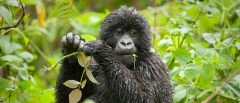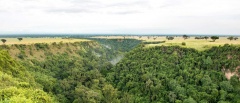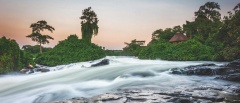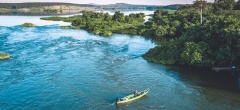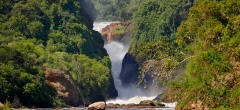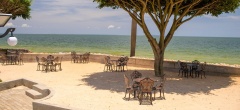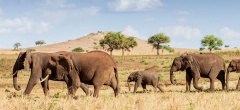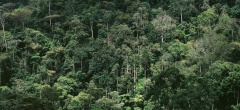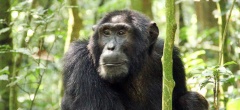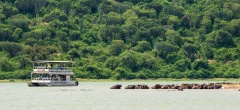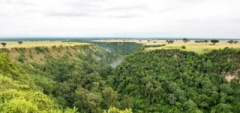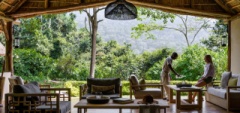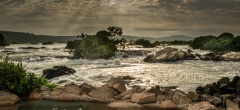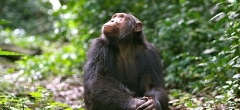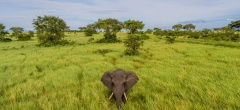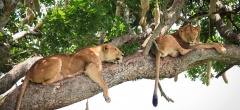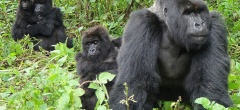Uganda
A diverse country with something for everyone!
Sitting on the equator in East Africa, Uganda is a country that is becoming increasingly popular to visit as it offers such as diverse experience in Africa. The country is bordered by six countries and apart from Rwanda, Uganda is relatively small compared to these neighbouring countries.
That said, this relatively small country is home to an exceptional variety of landscapes, ecosystems, animals, bird life and mountains. There are both typical East African savannahs, as well as central African rain forests. With 10 national parks and several nature/game reserves, Uganda has the big five (elephant, buffalo, lion, leopard and rhino) so the safari experience is good, but the country as a whole, is more renowned for its primate and bird life experience.
Best time to visit Uganda
Uganda receives abundant rainfall, so the country is always green. The temperatures are warm throughout the year but there are better times to visit than others. The period of June to September is regarded one of the best as it is the dry season, so the wildlife is reliable and offers good trekking conditions for the chimpanzees and gorillas. Another good time to visit is Uganda is December to January, also offering dry and warm temperatures.
The tropical climate of Uganda is mild depending on altitude. February tends to be the hottest month (around 28’C) and July the coldest month (but still around 24’C on average). The period of March to May is the rainy season in Uganda, and many of the lodges around the country are closed.
No matter what time of year you travel to Uganda, the packing list is the same. Some of these items include comfortable, lighting clothing, garden gloves for gorilla treks, waterproof jackets and trousers, sunglasses, sun cream and lip protection (factor 20+) and binoculars.
Primates in Uganda
Uganda is home to more than 10 species of primates and of course, the most famous is the endangered mountain gorillas. There are only around 800 mountain gorillas left in the wild and Bwindi National Park homes half of that population! This fact, along with the considerable difference in the gorilla permit costs between Uganda and Rwanda, makes Uganda a very popular tourist destination.
The mountain gorillas live in Bwindi Impenetrable National Park (western Uganda), Maghinga National Park (southwest of the country). The other gorillas are spread across the Virunga Massif, which extends over the Democratic Republic of Congo and Rwanda.
The cost of a mountain gorilla permit in Uganda is $600 but from the 1st July 2020, this will increase up to $700 per person per trek. Although it may be seen as quite a substantial upfront cost, this money goes back into the parks conservation and protection scheme. It is also a preferred destination as, although it is a little harder to access than Rwanda, the permit costs are half the price (Rwanda currently sell at $1,500 per person per trek). To find out more about gorilla trekking in Uganda, please click here.
The other main draw to Uganda, from a primate perspective, is that there are several destinations which home chimpanzees. Uganda has both habituated and un-habituated chimpanzees so depending on what experience you are looking for, you can head to different parks in the country.
For a chimpanzee trek to see a group of habituated chimpanzees, Kibale Forest National Park is the best option. This park is located in the southwestern region of the country and is accessed via plane or road (you can fly into this park from Murchison Falls in the north, or drive from nearby destinations such as Queen Elizabeth and Bwindi).
In Kibale, a chimpanzee trekking experience will allow you to spend approximately an hour with these mesmerizing primates. You will observe them swinging in trees, playing with one another and feeding around you – unfazed by your activity and presence. The group size is 6 people, accompanied by a guide of the Uganda Wildlife Authority (UWA). To find out more about chimpanzee trekking in Uganda, please click here.
Birding in Uganda
The bird life in Uganda is, arguably, one of the best in all of Africa. Uganda is home to approximately 1100 bird species that constitutes 50% of the Africa’s bird species and 11% of the world’s bird species count. A significant percentage of the bird species are endemic. Western Uganda, in Murchisons Falls in particular, is excellent as you can often identify 400 species of bird!
The most sought-after bird to see in Uganda is the shoebill stork. The shoebill is a large, pre-historic-looking bird that can weigh up to 6 kilograms and with an enormous head size, it is also referred to as the “King Whale-Head”.
The shoebill can be seen in several destinations in Uganda including Murchison’s Falls National Park, but the most reliable being the Mabamba Swamp, located relatively close to the city of Kampala. On route from Kampala to Mabamba Swamps, you can look out for papyrus specialities such as the Papyrus Gonolek, White Winged Warbler, Northern Brown Throated Weaver, Golden-Backed Weaver and the Orange Weaver to name a few.
Most of the birding in the Mabamba Swamps is done by canoe and cruising through the swamps and waterways is a great way to look for the rare Shoebill Stork. The guides are exceptionally knowledgeable in the flora, fauna and bird life, and we keep an eye out for other specialist birds in the Mabamba Swamps, including the African Rail, Allen’s and Purple Gallinule, Squacco Heron, Purple and Grey Herons, and a variety of Egrets.
The people of Uganda
The people of Uganda are referred to as some of ‘Africa’s friendliest people’ (although there are many countries in Africa who claim that as well)! The country is made up of approximately 60 tribes that stem from 4 main ethnic groups. These include the Bantu, the Sudainic, the West Nilotes and the East Nilotes. Each of these tribes speak its own dialect but the official language of the country is English.
Swahili is also commonly understood, which is a language spoken in East Africa (particularly Kenya and Tanzania). The Luganda is another widely spoken language, so it is common your guide will speak several and understand several languages and dialects.

